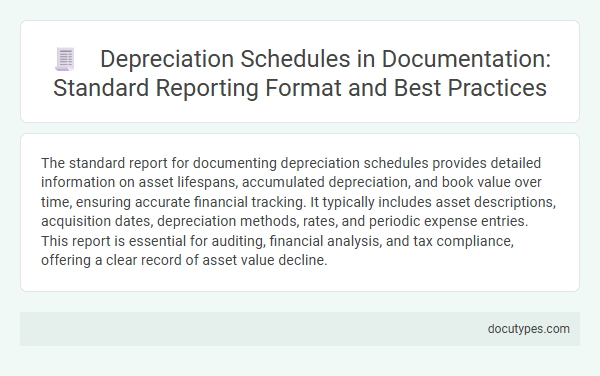The standard report for documenting depreciation schedules provides detailed information on asset lifespans, accumulated depreciation, and book value over time, ensuring accurate financial tracking. It typically includes asset descriptions, acquisition dates, depreciation methods, rates, and periodic expense entries. This report is essential for auditing, financial analysis, and tax compliance, offering a clear record of asset value decline.
Introduction to Depreciation Schedules in Documentation
Depreciation schedules provide a detailed record of asset depreciation over time, essential for accurate financial reporting. Your understanding of standard depreciation report formats ensures compliance with accounting principles and enhances documentation clarity.
- Purpose of Depreciation Schedules - They track the allocation of an asset's cost across its useful life for financial statement accuracy.
- Standard Report Structure - Typically includes asset details, acquisition date, depreciation method, useful life, and accumulated depreciation.
- Importance in Documentation - Serves as proof of asset valuation adjustments and supports tax and audit requirements.
Importance of Standard Reporting Formats
The standard report for documenting depreciation schedules provides a clear and organized overview of asset depreciation over time. It details asset categories, depreciation methods, useful life, and accumulated depreciation values.
Standard reporting formats ensure consistency, accuracy, and easy comparison across accounting periods. Your financial records become more reliable, supporting compliance with regulatory requirements and enhancing decision-making processes.
Key Components of a Depreciation Schedule
What is the standard report for documenting depreciation schedules? A depreciation schedule report provides a comprehensive overview of an asset's value reduction over time. You will find detailed entries such as asset description, acquisition date, cost, depreciation method, useful life, and accumulated depreciation included.
Common Depreciation Methods Used in Reporting
| Standard Report for Documenting Depreciation Schedules | |
|---|---|
| Purpose | To provide a detailed account of asset depreciation over time for accurate financial reporting and compliance. |
| Key Components |
|
| Common Depreciation Methods Used in Reporting | |
| Straight-Line Method | Allocates equal depreciation expense each year over the asset's useful life. Calculated by dividing the depreciable base by the estimated useful life. |
| Declining Balance Method | Accelerated depreciation method applying a fixed rate to the reducing book value, resulting in higher expenses in earlier years and lower in later years. |
| Sum-of-the-Years'-Digits (SYD) Method | Accelerated method where depreciation is based on a decreasing fraction of the depreciable base. The denominator is the sum of the digits of the asset's useful life. |
| Units of Production Method | Depreciation expense is based on the actual usage, activity, or units produced by the asset relative to its total expected output. |
| Usage in Reporting | Reports must specify which method is used and justify suitability based on asset type, industry standards, and regulatory requirements to support consistency and transparency. |
Structuring Depreciation Data for Clarity
The standard report for documenting depreciation schedules systematically records asset details, acquisition dates, useful life, and accumulated depreciation. Structuring depreciation data for clarity involves organizing information into clear sections, allowing easy tracking of each asset's value over time. Your report should present this data in a concise, tabular format to enhance understanding and facilitate financial analysis.
Best Practices for Documenting Depreciation
The standard report for documenting depreciation schedules typically includes detailed asset descriptions, acquisition dates, cost basis, accumulated depreciation, and net book values. Best practices emphasize accuracy in recording asset details, consistent application of depreciation methods, and regular updates to reflect asset disposals or impairments. Thorough documentation ensures compliance with accounting standards and provides clear visibility for financial analysis and audits.
Compliance and Regulatory Considerations
The standard report for documenting depreciation schedules is the Depreciation Expense Report, which provides detailed information on asset values, depreciation methods, and accumulated depreciation. This report ensures accurate financial tracking and supports compliance with accounting standards such as GAAP and IFRS.
Compliance requires the report to include asset identification, useful life estimates, depreciation methods used, and periodic expense calculations. Regulatory bodies often mandate regular updates and audits of depreciation schedules to prevent misstatements in financial reporting. Accurate documentation helps organizations meet tax regulations and financial disclosure requirements effectively.
Integrating Depreciation Schedules with Financial Reports
The standard report for documenting depreciation schedules typically includes detailed asset descriptions, depreciation methods, and accumulated depreciation values. Integrating these schedules with financial reports enhances transparency and accuracy in financial statements.
- Depreciation Schedule Overview - Lists all fixed assets along with acquisition dates, costs, useful life, and depreciation methods applied.
- Consistency with Financial Statements - Aligns depreciation data with balance sheets and income statements to ensure synchronization of asset values and expense recognition.
- Facilitates Audit and Compliance - Provides auditors and stakeholders with clear documentation supporting depreciation calculations and adherence to accounting standards.
Your financial reporting process benefits from integrating depreciation schedules to improve decision-making and regulatory compliance.
Challenges in Depreciation Documentation and Solutions
The standard report for documenting depreciation schedules provides a structured overview of asset value reductions over time. It ensures compliance with accounting standards and supports financial decision-making.
Challenges in depreciation documentation include data accuracy, compliance complexity, and reporting consistency. Solutions focus on automation, standardized processes, and regular audit controls.
- Data Accuracy Issues - Incorrect asset information can lead to depreciation errors impacting financial reports.
- Compliance Complexity - Adhering to multiple accounting standards complicates schedule documentation and reporting.
- Inconsistent Reporting - Variability in methods or formats hinders clear communication and audit readiness.
What Is the Standard Report for Documenting Depreciation Schedules? Infographic

